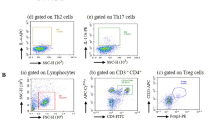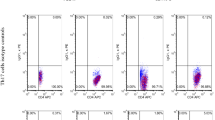Abstract
Background
Accumulating evidence indicates that cells expressing Toll-like receptors (TLRs) play an important role in allergic diseases. The authors undertook this study to explore the hypothesis that TLR-mediated inflammatory signals are important from the perspective of asthma management.
Methods
The expressions of TLR1, TLR2, TLR3, TLR4, TLR6, and TLR9 and levels of pro-inflammatory cytokines (TNF-α, IL-1β, IL-6, IL-8, and IFN-γ) on the peripheral blood mononuclear cells (PBMCs) of 36 stable asthmatics on treatment (the on-treatment group), 15 asthmatics (the treatment-naïve group) before and after a 7-day course of oral prednisolone (30 mg/day), and on the PBMCs of 15 healthy controls were measured after in vitro stimulation using TLR-specific ligands.
Results
In the on-treatment group, TLR1, TLR2, TLR6, and TLR9 expressions on PBMCs were significantly different between asthmatics and controls. And the expression of TLR4 on PBMCs and TNF-α production stimulated by lipopolysaccharide (LPS), were significantly higher in mild to moderate than in severe asthmatics. Interestingly, in the treatment-naïve group, short-term prednisolone significantly increased LPS-induced TNF-α and IFN-γ productions by PBMCs.
Conclusion
TLR-mediated inflammatory signals contribute to the development and severity of asthma and are not reduced by glucocorticoid treatment, which suggests that a TLR-specific antagonist and glucocorticoid are required for the effective control of airway inflammation in asthmatics.




Similar content being viewed by others
Abbreviations
- LPS:
-
Lipopolysaccharide
- PAMPs:
-
Pathogen-associated molecular patterns
- PBMCs:
-
Peripheral blood mononuclear cells
- PGN:
-
Peptidoglycan
- TLRs:
-
Toll-like receptors
References
Medzhitov R. Toll-like receptors and innate immunity. Nat Rev Immunol. 2001;1:135–45.
Koch A, Knobloch J, Dammhayn C, et al. Effect of bacterial endotoxin LPS on expression of INF-gamma and IL-5 in T-lymphocytes from asthmatics. Clin Immunol. 2007;125:194–204.
Sukkar MB, Xie S, Khorasani NM, et al. Toll-like receptor 2, 3, and 4 expression and function in human airway smooth muscle. J Allergy Clin Immunol. 2006;118:641–8.
Lun SW, Wong CK, Ko FW, et al. Expression and functional analysis of toll-like receptors of peripheral blood cells in asthmatic patients: implication for immunopathological mechanism in asthma. J Clin Immunol. 2009;29:330–42.
Woodruff PG, Khashayar R, Lazarus SC, et al. Relationship between airway inflammation, hyperresponsiveness, and obstruction in asthma. J Allergy Clin Immunol. 2001;108:753–8.
Fahy JV. Eosinophilic and neutrophilic inflammation in asthma: insights from clinical studies. Proc Am Thorac Soc. 2009;6:256–9.
Michel O. Role of lipopolysaccharide (LPS) in asthma and other pulmonary conditions. J Endotoxin Res. 2003;9:293–300.
National Institutes of Health. National Heart, Lung, and Blood Institute. 2007. National asthma education and prevention program expert panel report II: guidelines for the diagnosis and management of asthma. U.S. Department of Health and Human Services, Bethesda, MD. NIH Publication No. 08-4051
Boulet LP, Becker A, Bérubé D, et al. Canadian asthma consensus report. Can Med Assoc J. 1999;161(Suppl11):S1–62.
Ungar WJ, Champman KR, Santos MT. Assessment of a medication-based asthma index for population research. Am J Respir Crit Care Med. 2002;165:190–4.
Camateros P, Moisan J, Hénault J, et al. Toll-like receptors, cytokines and the immunotherapeutics of asthma. Curr Pharm Des. 2006;12:2365–74.
Brightling C, Berry M, Amrani Y. Targeting TNF-alpha: a novel therapeutic approach for asthma. J Allergy Clin Immunol. 2008;121:5–10.
Michel O. Role of lipopolysaccharide (LPS) in asthma and other pulmonary conditions. J Endotoxin Res. 2003;9:293–300.
Zhang N, Truong-Tran QA, Tancowny B, et al. Glucocorticoids enhance or spare innate immunity: effects in airway epithelium are mediated by CCAAT/enhancer binding proteins. J Immunol. 2007;179:578–89.
Schleimer RP. Glucocorticoids suppress inflammation but spare innate immune responses in airway epithelium. Proc Am Thorac Soc. 2004;1:222–30.
Morjaria JB, Chauhan AJ, Babu KS, et al. The role of a soluble TNFα receptor fusion protein (etanercept) in corticosteroid refractory asthma: a double blind, randomised, placebo controlled trial. Thorax. 2008;63:584–91.
Erin EM, Leaker BR, Nicholson GC, et al. The effects of a monoclonal antibody directed against tumor necrosis factor-α in asthma. Am J Respir Crit Care Med. 2006;174:753–62.
Wenzel SE, Barnes PJ, Bleecker ER, et al. A randomized, double-blind, placebo-controlled study of tumor necrosis factor α blockade in severe persistent asthma. Am J Respir Crit Care Med. 2009;179:549–58.
Yang M, Kumar RK, Foster PS. Interferon-gamma and pulmonary macrophages contribute to the mechanisms underlying prolonged airway hyperresponsiveness. Clin Exp Allergy. 2009;40:163–73.
Jeon SG, Oh SY, Park HK, et al. TH2 and TH1 lung inflammation induced by airway allergen sensitization with low and high doses of double-stranded RNA. J Allergy Clin Immunol. 2007;120:803–12.
Kumar RK, Webb DC, Herbert C, et al. Interferon-gamma as a possible target in chronic asthma. Inflamm Allergy Drug Targets. 2006;5:253–6.
Sin DD, Sutherland ER. Obesity and the lung: 4. Obesity and asthma. Thorax. 2008;63:1018–23.
Babu KS, Salvi SS. Aspirin and asthma. Chest. 2000;118:1470–6.
Nahm DH, Lee KH, Shin JY, et al. Identification of alpha-enolase as an autoantigen associated with severe asthma. J Allergy Clin Immunol. 2006;118:376–81.
Acknowledgments
This work was supported by a grant of the Korea Health 21 R&D Project (A030001) from the Ministry of Health and Welfare, Republic of Korea, and by a grant from Seoul National University Hospital (0420061070).
Author information
Authors and Affiliations
Corresponding author
Electronic supplementary material
Below is the link to the electronic supplementary material.
ESM 1
(DOC 61 kb)
Rights and permissions
About this article
Cite this article
Chun, E., Lee, SH., Lee, SY. et al. Toll-like Receptor Expression on Peripheral Blood Mononuclear Cells in Asthmatics; Implications for Asthma Management. J Clin Immunol 30, 459–464 (2010). https://doi.org/10.1007/s10875-009-9363-z
Received:
Accepted:
Published:
Issue Date:
DOI: https://doi.org/10.1007/s10875-009-9363-z




